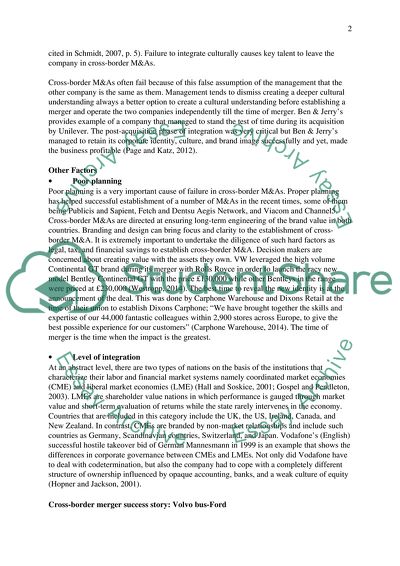Cite this document
('Mergers and acquisitions failures are often due to problems of Essay - 1, n.d.)
'Mergers and acquisitions failures are often due to problems of Essay - 1. https://studentshare.org/human-resources/1850998-mergers-and-acquisitions-failures-are-often-due-to-problems-of-integrating-the-different-cultures-and-workforces-of-the-combined-firms-pucik-et-al-in-harzing-a-w-and-pinnington-a-2011-121-international-human-resource-management-sage
'Mergers and acquisitions failures are often due to problems of Essay - 1. https://studentshare.org/human-resources/1850998-mergers-and-acquisitions-failures-are-often-due-to-problems-of-integrating-the-different-cultures-and-workforces-of-the-combined-firms-pucik-et-al-in-harzing-a-w-and-pinnington-a-2011-121-international-human-resource-management-sage
('Mergers and Acquisitions Failures Are Often Due to Problems of Essay - 1)
'Mergers and Acquisitions Failures Are Often Due to Problems of Essay - 1. https://studentshare.org/human-resources/1850998-mergers-and-acquisitions-failures-are-often-due-to-problems-of-integrating-the-different-cultures-and-workforces-of-the-combined-firms-pucik-et-al-in-harzing-a-w-and-pinnington-a-2011-121-international-human-resource-management-sage.
'Mergers and Acquisitions Failures Are Often Due to Problems of Essay - 1. https://studentshare.org/human-resources/1850998-mergers-and-acquisitions-failures-are-often-due-to-problems-of-integrating-the-different-cultures-and-workforces-of-the-combined-firms-pucik-et-al-in-harzing-a-w-and-pinnington-a-2011-121-international-human-resource-management-sage.
“'Mergers and Acquisitions Failures Are Often Due to Problems of Essay - 1”. https://studentshare.org/human-resources/1850998-mergers-and-acquisitions-failures-are-often-due-to-problems-of-integrating-the-different-cultures-and-workforces-of-the-combined-firms-pucik-et-al-in-harzing-a-w-and-pinnington-a-2011-121-international-human-resource-management-sage.


